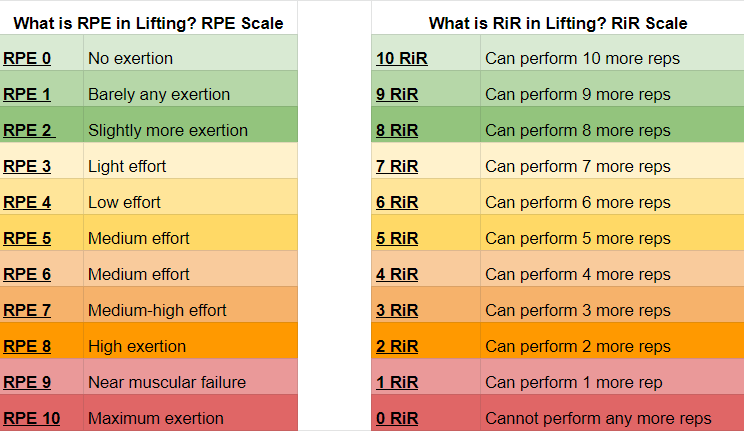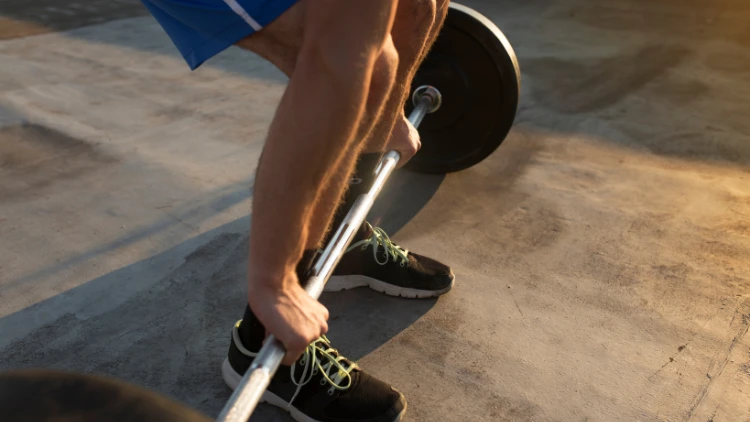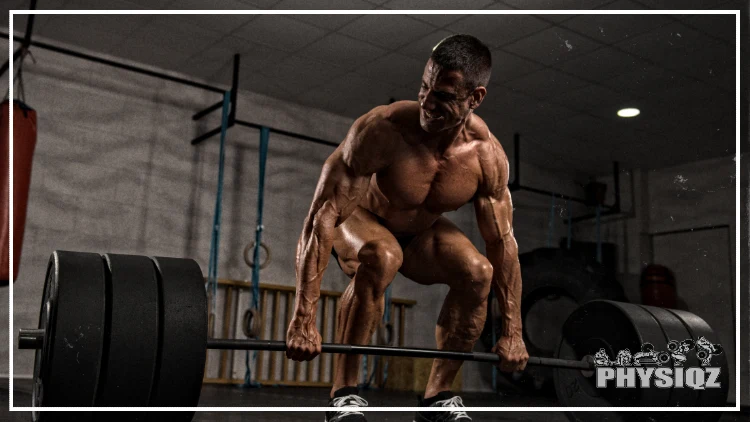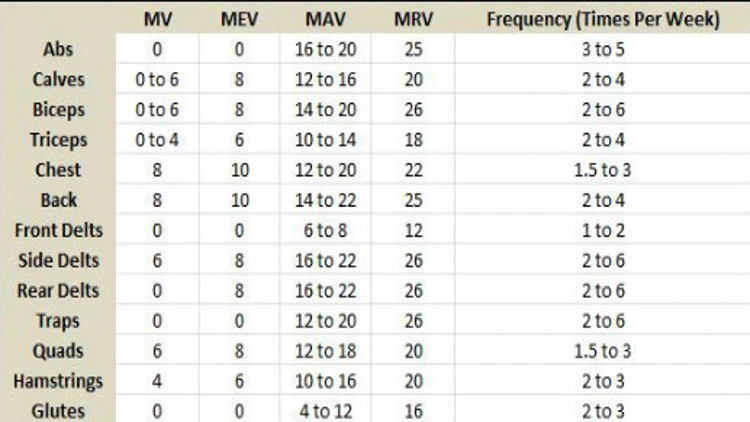
Understand what RPE means in lifting, and if it’s distinct, grasp the concept of RiR in lifting.
While both are useful tools to gauge intensity, they differ in key ways and when they’re not used appropriately, they’re both bad methods that should be avoided at all costs.
The reason for this is that if lifters solely rely on RPE or RiR as signs of progress, these autoregulating tools can provide excuses for an athlete to train sub-optimally rather than sticking to a plan designed around volume landmarks such as minimum effective volume, maximum adaptive volume, and maximum recover volume – which we’ll get to below.
What Is the Significance of RiR in Fitness? What Does RiR Mean in Lifting?
The popular RiR stands for reps in reserve and this is an autoregulatory tool that uses a subjective measure of how close a lifter is to failure during a set.1
For those not familiar, autoregulation is a tool to help trainers and coaches individualize programs for their trainees that are largely based on fatigue, mental subjectivity, and the coaches discretion.2
Part of assessing an athlete’s performance is using the RiR 1-10 scale (similar to RPE, discussed later) that corresponds with how many reps a lifter could still do before muscular failure.
For example, a lifter could be working at an RiR of 1 on a set of 12 reps, or in essence, they would have one rep in reserve. In this scenario, the lifter should be able to do one more rep for a total of 13 reps before failure, but instead, they are stopping the reps at twelve to help manage fatigue and still elicit enough stimuli.
If that same lifter trained with an RiR 2, the lifter would stop at 12 reps still, but they felt they could have performed a total of 14 reps, for a RiR or reps in reserve of two.
Getting To Know RPE in Lifting: Table
Below is a RiR chart that breaks down each value:
| RiR Scale for Lifting | |
| 10 RiR | Can perform 10 more reps |
| 9 RiR | Can perform 9 more reps |
| 8 RiR | Can perform 8 more reps |
| 7 RiR | Can perform 7 more reps |
| 6 RiR | Can perform 6 more reps |
| 5 RiR | Can perform 5 more reps |
| 4 RiR | Can perform 4 more reps |
| 3 RiR | Can perform 3 more reps |
| 2 RiR | Can perform 2 more reps |
| 1 RiR | Can perform 1 more rep |
| 0 RiR | Cannot perform any more reps |
Athletes who used previous performance-based RiR showed improvement in strength training over strict pre-determined strength progression.3 The important part to note is the previous performance-based which means using what a lifter knows they can do as a reference to their RIR, therefore RiR is a valuable tool when it is anchored.4
Anchoring is a way to provide an objective measure to each RiR value by connecting RIR to something like a previous performance or within another framework, discussed later. An example of anchoring is if an athlete is assigned 8 reps of bench presses at RiR 4. If the athlete knows they can do 200lb for 12 reps on the bench press, then they know it’s possible to perform 8 reps with 4 reps in the tank, or an RiR of 4; which means their RiR is anchored to that previous performance value.
While RiR can be a valuable tool, its relevance is dragged down by the critical flaw of being subjective.5
Without anchoring, most practitioners of RiR (and other autoregulatory tools) will be inaccurate with their RiR estimations and have worse training overall so lifters should avoid using RiR until they have a strong understanding of their performance.6
What Is the Best or Ideal RiR for Muscle Growth?
Once you understand RiR in lifting, it’s crucial to recognize that an RiR of 0-4 is ideal for muscle growth. Within this range, a lifter approaches failure closely enough to stimulate a near-optimal growth response.7

Source: SrdjanPav via Canva.com8
A RiR 5-10 can still stimulate muscle growth; however, with so many reps in reserve, the corresponding musculature may not be pushed hard enough to maximize a training session. At RiR 0, the muscle is pushed to its limit and will grow and repair, but the set stops right before failure, which may increase the risk of injury and excessive fatigue.
Therefore, repeated training sets to muscular failure or an RiR of 0 should be limited to lessen the chances of injury and mitigate fatigue within a mesocycle. Therefore, when inquiring about the meaning of RiR in fitness or lifting, it’s important to recognize that pushing to failure on every set may not always be the most effective approach.
The main benefit of RiR is to maximize any training day despite how a lifter feels on any given day because the range of 0-4 RiR will guarantee every set is optimal regardless of a lifter’s daily physical and psychological fatigue on any given day, in theory.9
Of course, RiR can become a crutch when an athlete uses RiR as an excuse to not push themselves as hard as they could when their fatigue is higher than usual. Anchoring, as discussed before, can help mitigate the subjectivity issue of RiR since it will be previous performances based.
However, the evidence supporting RiR 0-4 being optimal may not be as accurate of the ideal RiR range as the industry may believe.10 In one study, participants training at 0-4 RiR had similar muscle growth to participants training at 5-7 RiR.11 In other cases, lower fatigue hypertrophy, or muscle growth, programs have been shown to be effective as well due to lower systemic fatigue.
And at the end of the day, lower fatigue can allow for more training sessions and potentiate greater progression.12 While this is not a complete condemnation of the use of RiR, both lifters and coaches need to understand that RiR is not a perfect system. Whether low RiR or high RiR is superior is inconclusive at best and there are better ways to train regardless.
Some lifters might find that low RiR works better for them and some may find that high RiR works better for them so keep on experimenting.
How To Estimate Reps in Reserve (RiR)
While RiR is an effective tool, no tool has any value without a baseline. A lifter can call out an RiR in their head or out loud during a set and continue performing reps to see if they are correct in estimating their RiR.
For example, a lifter may get under a squat bar for ten reps. Once the lifter reaches rep 10, they gauge how many reps they can continue to perform and check if they are correct by continuing.
However, novice lifters tend to be more inaccurate when estimating how many reps they can do corresponding to their estimated RiR compared to experienced lifters.13 For one, lifters come in different styles.
Some lifters can grind through several more reps after their rep velocity slows down, while on the other side of the coin, some lifters are explosive. These lifters have the same rep speed on the last reps before failure as their first reps.
In addition, rep velocity patterns can be different from lift to lift. A lifter would have to calculate their RiR for each exercise they do to have a semi-accurate gauge.
An advanced lifter would have an easier time gauging their RiR thresholds than newer lifters; however, advanced lifters may not be as accurate with their RiR as they would like since they have shown to have a tendency to underestimate their RiR by one to two reps, which, while that is better than novice lifters, advanced lifters may not be training optimally either.14
Considering this, understanding RiR in lifting becomes an unreliable tool for both beginners and advanced lifters.
Understanding the Mental & Psychological Aspects of RiR
After thorough examination of RiR, understanding what RiR entails in lifting boils down to grasping the psychological aspect and accurately assessing RiR based on one’s personal sensations.
Autoregulatory tools are not just affected by a muscle’s ability to produce force and RiR as well as other self-regulatory systems may be dictated by psychological factors as well. For example, pain threshold can dictate their performance subjectively. As lactate builds in a muscle, a burning sensation starts and this may make some gym goers underestimate their next rep.
While some lifters may be able to ignore this, others may perceive a higher degree of exertion. The subjectivity of pain and effort may lead to lifters pushing themselves past the desired RiR or calling off a set earlier than their prescribed RiR.
What Does RiR Mean In Lifting & Why It Can Actually Be a Bad Thing To Use
Secondly, daily fluctuations may affect the subjective judgment of RiR. One day, an athlete may feel exhausted from work, and their RiR 2 may look different than last week. To paint a clearer picture, say that the athlete was assigned back squats.
On week one, they have ten reps at RiR 2, yet they know they can back squat 305lb for 12 reps. So, this week, they do 305lb for ten reps, but the next week, they have midterms and are mentally exhausted.
They come into the training session and when they get under 305lb on the back squat for 10 is now a RiR 0. While this situation is still optimal, it does affect their progression, recovery, and performance tracking negatively.
To avoid this, lifters should avoid using RiR in their training or continually experiment to learn how to gauge their RiR. However, it’s crucial to genuinely understand the distinctions between RiR and RPE in lifting.
Understanding RPE in Lifting: Rating of Perceived Exertion Explained
While there are other autoregulatory tools like RPE, it’s essential to understand what RPE means in lifting. RPE, also known as Rating of Perceived Exertion, is a scale for autoregulation that was originally developed for endurance sports by Gunnar Borg.15 The system was originally a 6-20 scale used for any type of training such as swimming, running, and more, but later it was adapted for lifting and turned into a 1-10 scale.
Many powerlifting coaches use the 1-10 scale for their athletes’ autoregulation and it’s also worth noting that the 1-10 RPE scale translates directly to the RiR system, also known as RiR-based RPE.
To put it simply, it’s the inverse of RiR when instead of having a RiR of 2, it’d be an RPE of 8. See below for an example.
- RiR 0 = RPE 10
- RiR 1 = RPE 9
- RiR 2 = RPE 8
- RiR 3 = RPE 7
- RiR 4 = RPE 6
- RiR 5 = RPE 5
- RiR 6 = RPE 4
- RiR 7 = RPE 3
- RiR 8 = RPE 2
- RiR 9 = RPE 1
- RiR 10 = RPE 0
To elaborate, imagine a lifter is doing bicep curls with 45lb dumbbells. At a RPE 1, the lifter is not exerting much at all. They could theoretically do nine more reps. At RPE 2, they are giving more effort, but perhaps only one more rep’s worth of effort. At RPE 10, the lifter is pushing themselves to their limit and could not do anymore, or they cannot perform another rep even if they wanted to.
RPE 1-5 seldom is used since they often have a low stimulus and thus are not optimal for strength or hypertrophy development.
To provide another example, a strongman competitor is training for one of the various training events and wishes to practice their suitcase carrying. Their coach prescribes them to do ten reps of 30 yards each arm.
For this lifter, if they pick a 30lb dumbbell, at the end of this set, they are not tired at all, whereas if the lifter selected a 100lb dumbbell, they would have to commit all of their effort to finish the set. With a 30lb dumbbell, the lifter would have been training around an RPE of 1-3.
On the other hand, with the 100lb dumbbell, they were at an RPE of 9-10 or really, really having a hard time with it. At a RPE of 10, the training failure RPE value, a lifter’s injury risks are at their highest. RPE 10 is not prescribed often by coaches, and advanced lifters who choose to use RPE seldom use it.
Below is a complete RPE chart breaking down each value:
| RPE Scale for Lifting | |
| RPE 0 | No exertion |
| RPE 1 | Barely any exertion, able to do many more reps if it was |
| RPE 2 | Slightly more exertion, exhaustion or failure is nowhere in sight |
| RPE 3 | Light effort, can perform many more reps before failure |
| RPE 4 | Low effort, lower end of a warm-up set |
| RPE 5 | Medium effort, typical warm-up set |
| RPE 6 | Medium effort, upper end of a warm-up set |
| RPE 7 | Medium-high effort, could perform several more reps |
| RPE 8 | High exertion, could perform a few more reps |
| RPE 9 | Near muscular failure, may not be able to perform more reps |
| RPE 10 | Maximum exertion. Cannot perform any more reps/ muscular failure |
Consider that when inquiring about RPE in lifting, RPE scales may vary depending on the exercise and the sport. Power exercises correspond with significantly lower RPE than traditional and super slow training.16
Since RPE can be different from exercise to exercise, it can be difficult for a lifter to grasp RPE unless they analyze their RPE for each exercise in their training program. While it is viable to do this, it is quite a time sink when lifters could be focused on other methods to monitor their effort.
Less conventional exercise or endurance exercises may not fit into the RPE model that corresponds with a 1, 2, 3, or more reps worth of effort. Trainees should be advised not to use RPE until they have a grasp on their ability and limitations
RiR vs RPE: What’s the Difference?

Source: MRBIG_PHOTOGRAPHY via Canva.com17
In understanding RiR in lifting, it’s important to recognize that RiR and RPE share similarities. However, RPE applies to exertion in any exercise, whereas RiR is specific to activities involving repetitions.18
To provide an example where RiR and RPE will be functionally the same: A lifter is doing a 6-week powerlifting program that includes deadlifts. Their coach prescribed them to do a set of 8 reps at 225lbs at RPE 8. According to this assignment, the lifter should be able to do two more reps which could also be written as 2 RiR. A RPE 8 would be the same as an RiR of 2 in this scenario. Because in this example, the lifter should be able to do 10 deadlifts at 225lbs before muscular failure, but they are only going to do 8 reps instead. By anchoring RPE to RiR, the lifter has a more objective standard to follow and will be consistent with their training.
To illustrate how these are different: a lifter is performing farmer carries. The lifter’s coach assigns them to do ten reps of 50 yards at an RPE of 7. At an RPE of 7, the lifter may be able to use 100lbs in each hand. The coach cannot assign farmers carries at 3 RiR. According to RiR, the lifter should be able to do three more reps of 50 yards, but this lifter cannot complete 3 whole reps with 100lbs dumbbells so the stimulus would be completely different to make 3 RiR work.
In this case, RPE and RiR are not equivalent because, unlike a lift like a deadlift, farmer’s carries also have the component of distance, speed, etc. The actual reps of farmer carries are dissimilar to the reps of a conventional lift.
Even considering this, no RPE system perfectly corresponds to unconventional exercises, such as carries or isometrics.19 Anchoring RPE to an objective value for nontraditional lifts is difficult. Because unconventional activities and lifts are often not defined solely by reps, their RPE values must correspond to previous performance efforts.
Estimating RPE may be easy for max effort and minimum effort, but for all the ratings in between, it can be near impossible to be as consistent as possible.
RPE and RiR both rely on a lifter understanding of their previous performance and how it interplays with autoregulatory systems. Ultimately, it may be worth not using at all to maximize progress.
Understanding Volume Indicators & Landmarks Instead of Autoregulating Through RiR or RPE
As mentioned, the autoregulation and/or subjectivity of RiR and RPE can lead to subpar results in some lifters so volume indicators or landmarks will generally provide better results.
So unless you’re an advanced lifter or professional athlete, consider these landmarks first and foremost before dropping weights or sets due to RiR or RPE. Note each body part will be able to withstand various amounts of volume and elicit fatigue at a different rate.

The volume indicators are:
Maintenance Volume (MV)
Maintenance volume is exactly what it sounds like. It’s just enough volume to keep precious muscles from withering away. Also known as the bare minimum to keep size or strength. This can be achieved with about 6 sets per body part, per week.
Minimum Effective Volume (MEV)
The minimum effective volume is what it takes to elicit just enough stimuli to grow and is a great place to start the first week of a training program. The amount of reps to achieve MEV varies from person to person, body part to body part, and throughout a training program.
Maximum Adaptive Volume (MAV)
Maximum adaptive volume is the sweet spot where lifters will get the best results but it’s important to note that MAV will, or should continually increase until one meets their maximum recovery volume. The reason the number of reps varies in MEV also applies to MAV.
Maximum Recovery Volume (MRV)
Most programs should begin at minimum effective volume and slowly work towards maximum recovery volume – which is quite literally the most volume you can recover from and at this point, people may decide to overreach slightly but it’s imperative for new lifters to reload and restart back at maintenance volume for a few weeks.
Gym goers can usually realize they’re at MRV if they’ve plateaued or display other signs of fatigue. Each person will have their own volume landmarks, but the following chart can be used as a rough estimate until it’s figured out.
Truth be told, most don’t understand these indicators and solely rely on what other gym bros have told them about RiR and RPE so their gains suffer as a result.
Therefore, newer lifters should avoid RiR and RPE because they are advanced tools that can disrupt their progression if they do not understand their previous objective performance measures or fully comprehend the concepts of RiR and RPE in lifting.
References
1Mahaffey, K. (2022, 15 8). Reps in Reserve (RiR): What You Need to Know. NASM Blog. Retrieved August 15, 2022, from
<https://blog.nasm.org/reps-in-reserve>2Helms, E. (2017, August 30). The Science of Autoregulation • Stronger by Science. Stronger by Science. Retrieved August 16, 2022, from <https://www.strongerbyscience.com/autoregulation/>
3Helms, E. R., Kwan, K., Sousa, C. A., Cronin, J. B., Storey, A. G., & Zourdos, M. C. (2020, August 30). Methods for Regulating and Monitoring Resistance Training. Journal of Human Kinetic, 74(1), 23–42. PubMed <https://doi.org/10.2478/hukin-2020-0011>
4Popadic, E. (2021, December 13). RPE vs RiR: What Are The Differences? How To Use Them? | PowerliftingTechnique.com. Powerlifting Technique. Retrieved August 15, 2022, from <https://powerliftingtechnique.com/rpe-vs-RiR/>
5Hickmott, L. M., Chilibeck, P. D., Shaw, K. A., & Butcher, S. J. (2022). The Effect of Load and Volume Autoregulation on Muscular Strength and Hypertrophy: A Systematic Review and Meta-Analysis. Sports medicine – open, 8(1), 9 <https://doi.org/10.1186/s40798-021-00404-9>
6Steele, J., Endres, A., Fisher, J., Gentil, P., & Giessing, J. (2017). Ability to predict repetitions to momentary failure is not perfectly accurate, though improves with resistance training experience. PeerJ, 5(1), e4105
<https://doi.org/10.7717/peerj.4105>7Robinson, Z., Pelland, J., & Remmert, J. (2021, March 22). RiR and Muscle Growth — Data Driven Strength. Data Driven Strength. Retrieved August 16, 2022, from
<https://www.data-drivenstrength.com/articles/RiR-and-muscle-growth>8SrdjanPav. “Deadlift.” Canva. Accessed 11 April 2023. <https://www.canva.com/photos/MAEEff882Jk-deadlift/>
9Mahaffey, K. (2022, 15 8). Reps in Reserve (RiR): What You Need to Know. NASM Blog. Retrieved August 15, 2022, from <https://blog.nasm.org/reps-in-reserve>
10Robinson, Z., Pelland, J., & Remmert, J. (2021, March 22). RiR and Muscle Growth — Data Driven Strength. Data Driven Strength. Retrieved August 16, 2022, from <https://www.data-drivenstrength.com/articles/RiR-and-muscle-growth>
11Robinson, Z., Pelland, J., & Remmert, J. (2021, March 22). RiR and Muscle Growth — Data Driven Strength. Data Driven Strength. Retrieved August 16, 2022, from
<https://www.data-drivenstrength.com/articles/RiR-and-muscle-growth>12Robinson, Z., Pelland, J., & Remmert, J. (2021, March 22). RiR and Muscle Growth — Data Driven Strength. Data Driven Strength. Retrieved August 16, 2022, from <https://www.data-drivenstrength.com/articles/RiR-and-muscle-growth>
13Helms, E. R., Kwan, K., Sousa, C. A., Cronin, J. B., Storey, A. G., & Zourdos, M. C. (2020, August 30). Methods for Regulating and Monitoring Resistance Training. Journal of Human Kinetic, 74(1), 23–42. PubMed <https://doi.org/10.2478/hukin-2020-0011>
14Steele, J., Endres, A., Fisher, J., Gentil, P., & Giessing, J. (2017). Ability to predict repetitions to momentary failure is not perfectly accurate, though improves with resistance training experience. PeerJ, 5(1), e4105 <https://doi.org/10.7717/peerj.4105>
15Larson, S., Kristiansen, E., & van den Tillaar, R. (2021, January 12). Effects of subjective and objective autoregulation methods for intensity and volume on enhancing maximal strength during resistance-training interventions: a systematic review. PeerJ, 9(e10663) <https://doi.org/10.7717/peerj.10663>
16Egan, A. D., Winchester, J. B., Foster, C., & McGuigan, M. B. (2006). Using Session RPE to Monitor Different Methods of Resistance Exercise. Journal of sports science & medicine, 5(2), 289–29 <https://www.ncbi.nlm.nih.gov/pmc/articles/PMC3827571/>
17MRBIG_PHOTOGRAPHY. “Weight Lifting Dead Lift.” Canva. Accessed 11 April 2023. <https://www.canva.com/photos/MAEErE5iWYA-weight-lifting-dead-lift/>
18Popadic, E. (2021, December 13). RPE vs RiR: What Are The Differences? How To Use Them? | PowerliftingTechnique.com. Powerlifting Technique. Retrieved August 15, 2022, from <https://powerliftingtechnique.com/rpe-vs-RiR/>
19Lea, J. W.D., O’Driscoll, J. M., Coleman, D. A., & Wiles, J. D. (2021). Validity and reliability of RPE as a measure of intensity during isometric wall squat exercise. Journal of clinical and translational research, 7(2), 248–256 <https://www.ncbi.nlm.nih.gov/pmc/articles/PMC8177844/>